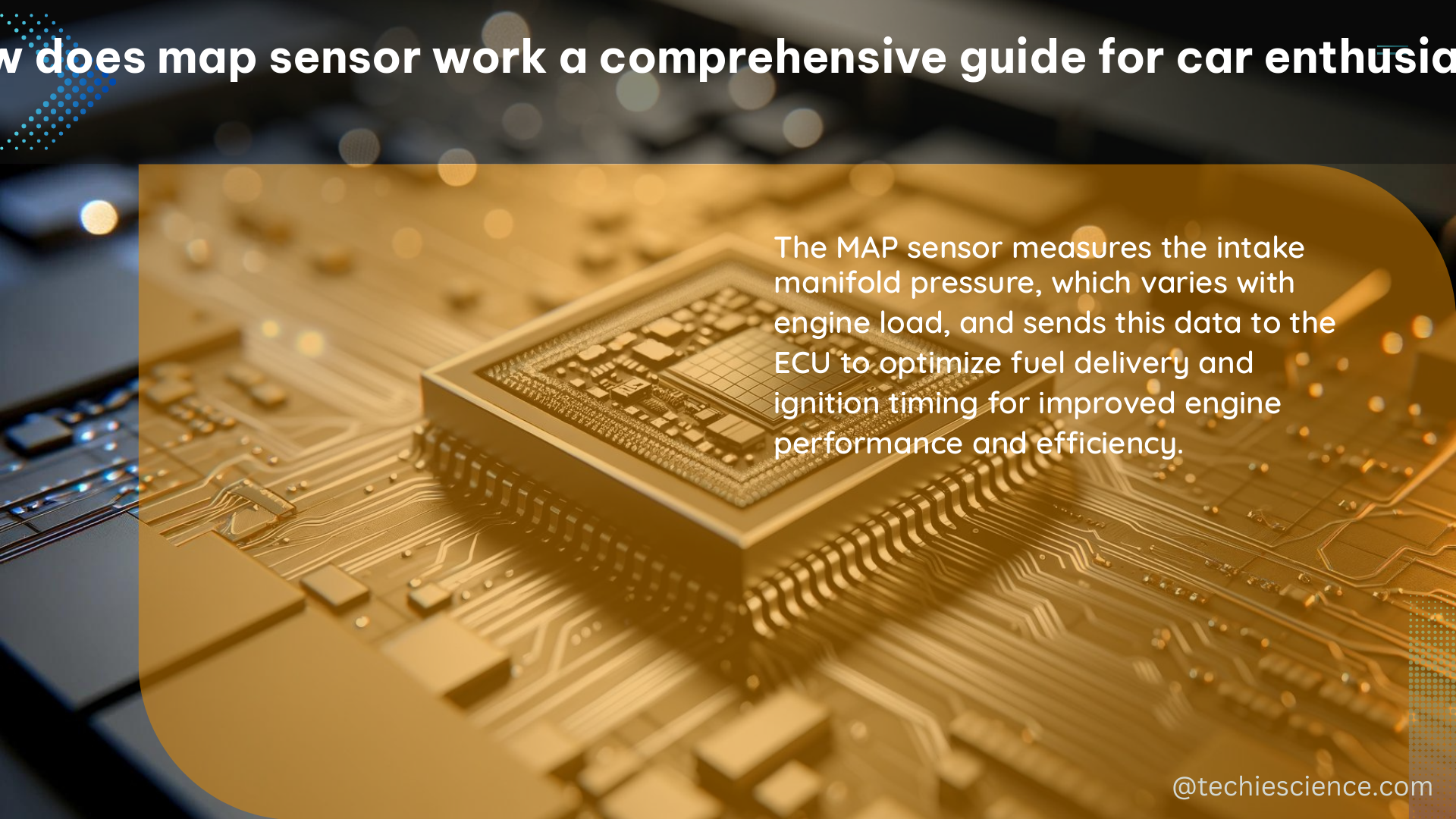The Manifold Absolute Pressure (MAP) sensor is a critical component in a car’s engine management system, responsible for measuring the pressure within the intake manifold and providing essential data to the Engine Control Unit (ECU) to optimize engine performance. This comprehensive guide will delve into the inner workings of the MAP sensor, its role in engine management, and how car enthusiasts can leverage this knowledge to diagnose and troubleshoot engine-related issues.
Understanding the Basics of MAP Sensors
A MAP sensor is designed to measure the absolute pressure within the engine’s intake manifold, which is directly related to the engine’s load and throttle position. This pressure data is then converted into an electrical signal and transmitted to the ECU, allowing it to make real-time adjustments to fuel delivery, ignition timing, and other critical engine parameters.
MAP sensors typically measure pressure in two units: kilopascals (kPa) or pounds per square inch (psi). The sensor’s output voltage or resistance varies depending on the measured pressure, with a higher manifold pressure resulting in a higher sensor voltage or lower resistance.
The Relationship Between Pressure, Voltage, and Resistance

To fully understand how a MAP sensor works, it’s essential to grasp the relationship between pressure, voltage, and resistance. A typical MAP sensor has a voltage range of 0.5 to 5 volts, with a 5-volt reference voltage provided by the ECU.
As the manifold pressure increases, the sensor’s resistance decreases, causing the voltage to rise. Conversely, as the pressure decreases, the resistance increases, and the voltage drops. This inverse relationship between pressure and resistance is a key characteristic of MAP sensors.
| Manifold Pressure | Sensor Resistance | Sensor Voltage |
|---|---|---|
| High | Low | High |
| Low | High | Low |
Interpreting MAP Sensor Data
MAP sensor data can be monitored and analyzed using an OBD-II (On-Board Diagnostics) scan tool, which allows you to view live data in real-time. This data can be invaluable in diagnosing engine performance issues, such as vacuum leaks, intake system blockages, or sensor malfunctions.
When analyzing MAP sensor data, it’s crucial to consider the driving conditions and engine load. For instance, at idle or steady cruise, the engine typically has the highest vacuum ratings, resulting in lower MAP sensor voltages. Conversely, at wide-open throttle, the vacuum is at its lowest, leading to higher MAP sensor voltages.
To interpret MAP sensor data effectively, car enthusiasts should be aware of the following:
- Idle or Steady Cruise: MAP sensor voltage should be around 1.0 to 1.5 volts, indicating high vacuum conditions.
- Wide-Open Throttle: MAP sensor voltage should be around 4.5 to 5.0 volts, indicating low vacuum conditions.
- Sudden Throttle Changes: MAP sensor voltage should respond quickly, reflecting the changes in manifold pressure.
- Abnormal Readings: Consistently higher or lower than expected MAP sensor readings may indicate a problem with the intake manifold, vacuum system, or the sensor itself.
Diagnosing Engine Performance Issues with MAP Sensor Data
By understanding how MAP sensors work and interpreting their data, car enthusiasts can effectively diagnose and troubleshoot various engine performance issues. Here are some common problems that can be identified using MAP sensor data:
- Vacuum Leaks: A vacuum leak in the intake system will cause the MAP sensor to read a lower-than-expected voltage, as the manifold pressure will be lower than normal.
- Intake System Blockages: A blockage in the intake system, such as a clogged air filter or a partially obstructed throttle body, will result in higher-than-expected MAP sensor voltages, as the manifold pressure will be higher.
- Sensor Malfunctions: A faulty MAP sensor or wiring issue can cause erratic or out-of-range readings, leading to engine performance problems and potential engine damage if left unaddressed.
Optimizing Engine Performance with MAP Sensor Data
By closely monitoring and analyzing MAP sensor data, car enthusiasts can make informed decisions to optimize their engine’s performance. This includes:
- Tuning Fuel Delivery: The ECU uses MAP sensor data to determine the appropriate fuel delivery, ensuring the engine operates at the optimal air-fuel ratio for maximum power and efficiency.
- Adjusting Ignition Timing: The ECU also relies on MAP sensor data to adjust the ignition timing, which is crucial for maximizing engine power and preventing knocking or pre-ignition.
- Monitoring Engine Load: MAP sensor data can provide valuable insights into the engine’s load, allowing enthusiasts to make adjustments to the suspension, tires, or gearing to improve overall vehicle performance.
Conclusion
The Manifold Absolute Pressure (MAP) sensor is a crucial component in a car’s engine management system, providing essential data to the ECU to optimize engine performance. By understanding how MAP sensors work, car enthusiasts can leverage this knowledge to diagnose and troubleshoot engine-related issues, as well as make informed decisions to enhance their vehicle’s performance.
This comprehensive guide has covered the basics of MAP sensors, the relationship between pressure, voltage, and resistance, and how to interpret MAP sensor data to identify and address common engine problems. With this knowledge, car enthusiasts can take their understanding of engine management to the next level and become more self-sufficient in maintaining and improving the performance of their vehicles.
References:
- Understanding the Map Sensor: Your Guide to Engine Performance
- Intro To MAP Sensor Data – YouTube
- How to read OBD live data: Step-by-step guide | OBDeleven

The lambdageeks.com Core SME Team is a group of experienced subject matter experts from diverse scientific and technical fields including Physics, Chemistry, Technology,Electronics & Electrical Engineering, Automotive, Mechanical Engineering. Our team collaborates to create high-quality, well-researched articles on a wide range of science and technology topics for the lambdageeks.com website.
All Our Senior SME are having more than 7 Years of experience in the respective fields . They are either Working Industry Professionals or assocaited With different Universities. Refer Our Authors Page to get to know About our Core SMEs.